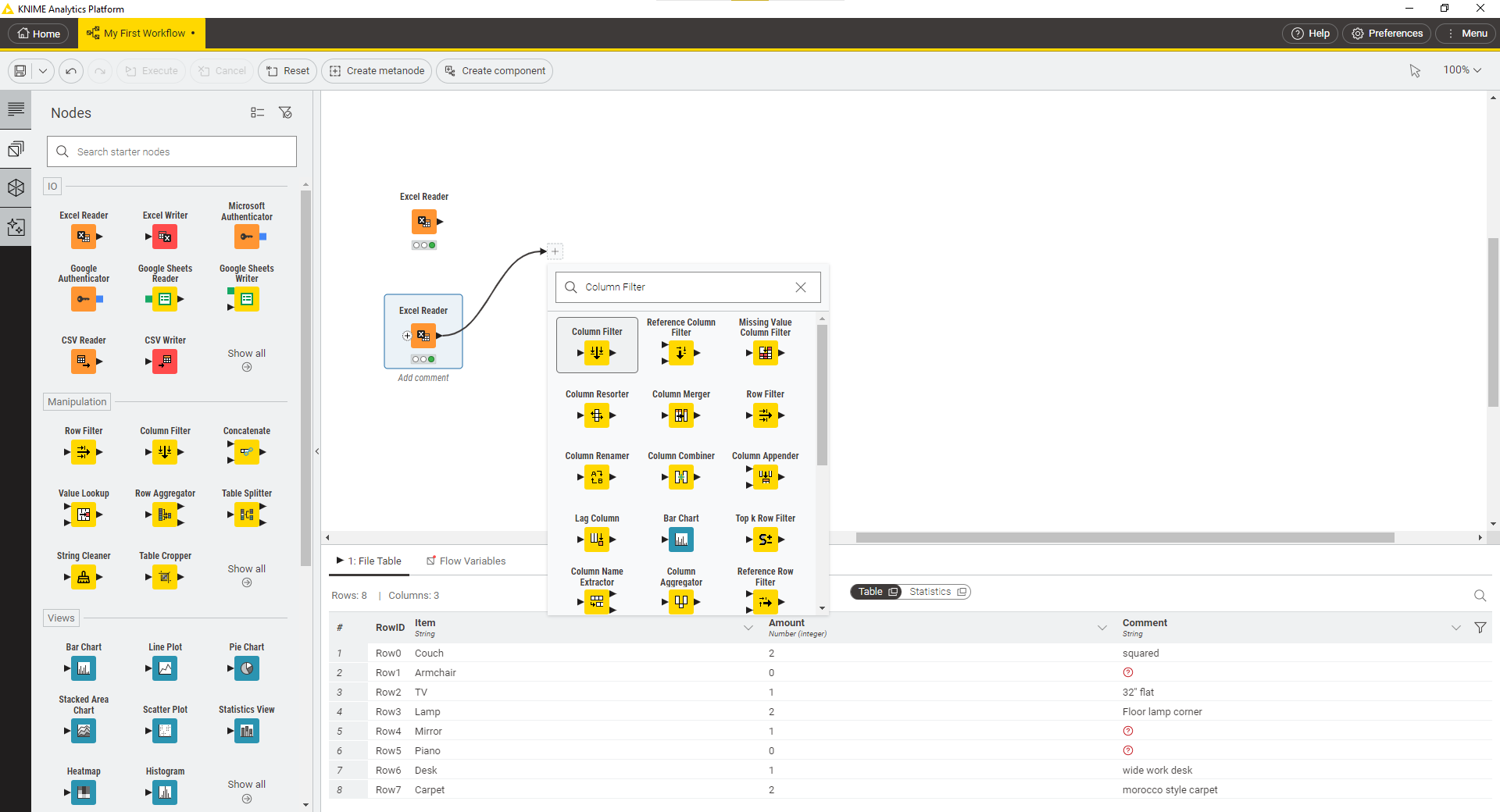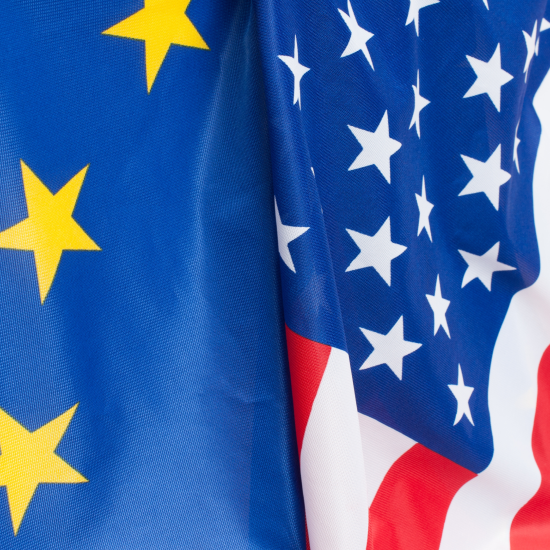AI is a transformative technology. However, as it rapidly evolves, there is growing awareness that it presents not just opportunities but also potential risks for society, the economy and security.
This article gives a you a short summary of how the EU and the US aim to improve the safety and security of AI technologies, and how KNIME Software can help support you in satisfying the various requirements of the new legislation, by giving you clear and auditable processes around GenAI and a central hub for all data-related workflows using AI.
What is AI governance?
AI governance is the process of setting guidelines, policies, and practices to manage the ethical, legal, and societal impacts of AI systems while fostering innovation. Companies create AI governance approaches internally, and governments create legislation to enforce minimum governance standards. The goal of AI governance is to safeguard data privacy, mitigate biases, protect copyright, and ensure transparent decision-making. AI governance enables organizations to develop and deploy AI technologies responsibly, minimizing harm to individuals and society.
The European Union and the United States are leading the AI governance debate, having both released AI frameworks. Both the EU’s AI Act and the US Executive Order on AI emphasize a risk-based approach but follow notably different pathways to AI regulation.
What’s included in the EU’s AI Act
The EU's AI Act is the world’s first legal framework for AI and came into force in August 2024. It sets clear legal boundaries on data quality, transparency, human oversight, and accountability to ensure AI innovation aligns with the EU’s fundamental rights and values.
The EU AI Act follows a risk-based approach, with a 4-tiered risk framework to classify AI systems:
- Unacceptable risk: Bans AI systems like government social scoring or voice-assisted toys promoting dangerous behaviors.
- High risk: Requires strict compliance for AI (e.g, risk assessment and mitigation, transparency, data governance, documentation, traceability, etc.) in critical areas like healthcare and finance.
- Limited risk: Mandates transparency for AI systems like chatbots and content generators (the outputs must be identifiable as artificially generated).
- Minimal risk: Allows voluntary guidelines for systems like spam filters and video games.
What’s included in the US Executive Order on AI
The US’s Executive Order represents a significant step toward a federal, risk-based AI framework. It is issue-focused, providing recommendations, guidelines, and initiatives for the safe and trustworthy development of AI. It reflects the US’s less prescriptive approach to AI governance, and relies on a mix of federal, state, and industry-specific laws for implementation.
The main issues it focuses on are:
- Safety standards
- Privacy protection
- Cyber security
- Equity against socio-economic and racial biases
- Promotion of innovation, competition and global leadership in AI.
How KNIME helps support AI governance
Let’s take a look at how selected KNIME features can help you meet AI regulatory standards. Here's a table that summarizes the main regulatory requirements and features, but read-on for a detailed explanation of each one.
| AI Regulation Requirement | KNIME Features |
| Transparency & Explainability | Visual workflows document every step of the data science process, making it easier to explain and audit workflows. Continuous Deployment for Data Science (CDDS) logs workflow state changes and validations for audits. |
| Reproducibility & Traceability | Full backward compatibility ensures reproducibility of workflows. Workflow versioning allows users to revert and audit past analyses. Note: There are always challenges in reproducing work with GenAI since models are non-deterministic and their training data may also be updated between the original workflow and the subsequent audit. |
| Human Oversight | KNIME offers an intuitive interface for interaction and intervention, with workflow control, monitoring, and human-in-the-loop analytics. Centralized oversight via KNIME Business Hub ensures governance and compliance. |
| Data Governance | Integrated platform for data access, validation, and integration. Credential encryption, team credential management, and data anonymization features ensure security and privacy compliance. |
| Model & Workflow Reliability | KNIME supports integration with tools like Giskard for bias detection and GenAI risk mitigation. How the workflow functions can also be explained, including how it reaches end results. |
| Consistency & Stability | Integrated deployment streamlines model development to production, ensuring consistency and compliance with governance frameworks. |
| Customization & Extensibility | Open-source platform supports custom extensions and integration with third-party tools, allowing adaptability to evolving regulatory requirements. |
| Data & AI Literacy | User-friendly interface and visual workflows promote data literacy across teams. KNIME Hub offers access to educational resources and workflows to support AI literacy and compliance. |
1. Visual workflows for documentation, transparency, and explainability
A major part of AI governance is about being able to document and explain what happens with the data along the different stages of the data science process.

When teams create data science and machine learning pipelines in KNIME, they use visual workflows to connect up different data operations. This visual approach inherently documents each development step, making it easier for all stakeholders to understand, interpret, and review a data science process.
This gives you the transparency and explainability you need to comply with AI governance regulations.
You can also log events with the Continuous Deployment for Data Science (CDDS) extension for KNIME Business Hub. For example, you can log workflow state changes and validations, making it easier for your organization to provide audits and regulatory reviews.
2. Versioning and monitoring features for reproducibility and human oversight
How can companies audit what happened to the data, why it happened, and know which data or analyses were actually run even years later? Reproducibility is a key requirement of AI frameworks, but how do you do it if your software is constantly updated?
KNIME ensures full backward compatibility for workflows, enabling seamless reproducibility of past analyses, even after software updates. You can also easily export workflows as self-contained, shareable files, and use versioning to revert to previous workflow versions – ensuring reproducibility, traceability and consistent results during audits or compliance checks.
AI regulations also require high-risk AI systems to include effective human oversight and easy human-machine interaction to minimize risk.
KNIME provides an intuitive interface for interaction, intervention, and model improvement with features for workflow control, execution monitoring, and human-in-the-loop analytics, You can also benefit from centralized oversight to manage AI deployments with KNIME Business Hub. This combines automated checks with manual validation to ensure compliance and reliable governance throughout the entire data science process.
3. Customization options for manageability and extensibility
AI and data science projects typically involve managing a complex stack of tools for tasks such as data ingestion, preprocessing, model building, validation, and deployment. This can lead to integration issues and maintenance challenges.
KNIME addresses this by offering an integrated platform. Most tasks can be managed within a single system, reducing the complexity of handling multiple tools and aligning with AI regulations’ emphasis on consistency, stability, and ease of auditing.
The data analytics and AI regulatory landscapes are dynamic. As needs and requirements change, companies need to adapt quickly.
KNIME’s open-source philosophy fosters community-driven innovation, flexibility and agility. This allows companies to access advanced analytics techniques, develop custom extensions and seamlessly integrate with third-party tools, making the software adaptable to evolving regulatory and operational requirements.
4. Data governance
Effective data governance is crucial for ensuring data quality, validation, and protection, especially within AI regulatory frameworks.
KNIME offers extensive capabilities for comprehensive data access, integration, and validation, helping detect issues like noise, schema inconsistencies, and model drift that could impact model reliability.
KNIME supports robust data security features like credential encryption, centralized management of team credentials, as well as tools for data anonymization to protect sensitive information. Its visual flows allow by design for the intuitive detection of data leakage risks, ensuring models are built securely.
For many compliance activities, organizations are required to externally document their processes. KNIME lets you capture the full workflow metadata for external documentation. This enables thorough tracking of libraries and external package calls, and helps organization address questions about data lineage, GDPR compliance, and model explainability
5. Algorithm support for advanced modeling and deployment
AI regulations require that organizations ensure model fairness and transparency.
With KNIME, you can build advanced machine learning and AI pipelines, and use features to interpret, understand and explain how models make decisions. KNIME can also integrate with tools (Giskard is just one example) to detect risks like misinformation or bias in GenAI applications to ensure responsible AI usage.
Organizations can more easily maintain compliance and reliability as they scale their analytics solutions with KNIME's Integrated Deployment. This feature streamlines the transition from model development to productionization, giving companies more consistency, fewer errors, and the ability to capture and store both creation and production processes, i.e. full support of governance and compliance reporting. Combined with KNIME Business Hub’s centralized controls, you benefit from ongoing monitoring and updates.
6. Extensive resources to promote data & AI literacy
AI regulations require that companies take measures to ensure an adequate level of AI literacy. But how can you ensure large-scale data science upskilling?
KNIME's visual workflows and user-friendly interface make data and AI literacy accessible across multi-discipline teams, enabling non-technical users to engage with the platform effectively.
KNIME Hub gives your teams easy access to a central repository of solutions, tools, workflows, and best practices, helping reduce implementation costs and supporting both beginners and advanced users. KNIME’s collaborative environment, comprehensive documentation and educational resources ensure that organizations stay agile, informed, and aligned amidst evolving AI and data analytics practices.
Get AI-ready with KNIME
Finding and implementing effective and practical controls for AI governance isn’t easy. That’s why we’ve built these AI-specific governance tools into KNIME so you can scale up your AI technologies and mitigate risks.
